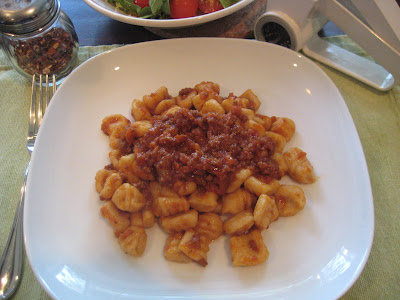Read my first restaurant review for 2010 on examiner.com
 Fig.1. These Sardinian gnocchi are firm and hearty. Finish your plate, lie down, undo the waist button on your pants, and see how long it takes to digest these pillows of goodness.
Fig.1. These Sardinian gnocchi are firm and hearty. Finish your plate, lie down, undo the waist button on your pants, and see how long it takes to digest these pillows of goodness. Those of you on a low carb regiment beware: This web site will overflow with pasta this year. My goal is to collect and document family, pasta recipes that are under threat of extinction; as well as study the evolution—from Italy to Canada—of various pasta dishes from an anthropological perspective. I’m doing this, along with a colleague of mine, to better understand what changes traditional cuisines undergo when produced intergenerationally, and within a new environment—all to better understand the link between food and national identity. If you feel like sharing your favourite ancestral pasta recipe, send it to me; if we get enough recipes, it just might be enough for a book down the line.
Let me begin with a very typical, Sardinian pasta dish called Malloreddus Al Sugo. The ingredients are akin to cavatelli, but with a texture and shape much like gnocchi. This is a great winter recipe and a good example of the island’s cucina rustica; malloreddus may take long to make, but they will also take a long time to digest—a trait common to the cucina povera dishes of Italy.
Semolina flour, water and saffron make up the pasta. (Over 50 percent of Italy’s saffron crop comes from Sardinia.) In North America, the use of saffron is often omitted, so is the wild boar meat traditionally used in the sauce. While boars run wild in Sardinia, they unfortunately do not in Montreal (boar meat—sanglier in French, cinghiale in Italian—is available through some butchers in the Atwater Market.); use regular sausage meat instead.
Malloreddus al Sugo di Maiale
Serves 4
Ingredients:
Malloreddus
2 cups semolina flour
1 tsp salt
1 tsp ground saffron (optional, but recommended)
¾ cup warm water
Sugo di Maiale
1 large onion, diced
4 cloves garlic, chopped
1 pound of Italian sausage, removed from casing
2/3 cup white wine
½ tsp saffron threads
1 ½ cans (28 oz) of whole, plum tomatoes
2 bay leaves
1 tsp dried chilli peppers
½ cup of freshly grated Pecorino Romano cheese
 Fig.2. I like to use the back of a fork when forming the pasta, a gnocchi board, available at Quincaillerie Dante, will also work.
Fig.2. I like to use the back of a fork when forming the pasta, a gnocchi board, available at Quincaillerie Dante, will also work.Directions:
For the pasta:
In a large bowl, dissolve the salt and saffron in warm water. Mound the semolina flour in the center of a large wooden board and form a well in the center. Add the water to the center. Incorporate the flour and water together using a fork, working your way evenly out of the center (make sure your well stays intact). The dough will start to hold together once all of the flour is incorporated (if the dough forms and holds before you have used up all of the flour leave it as is.) Continue to knead until the dough forms a complete mass. (Discard any small dried bits of dough) Knead on a well floured work surface for 5 minutes, dusting occasionally with flour to keep the dough from sticking to your hands. Wrap the ball of dough with a damp kitchen towel and let rest for 30 minutes. Break apart a small piece of dough (keep the unused dough wrapped or it will begin to dry) and roll into a ½ inch cylinder, cut cylinder into ¼ inch pieces. Press the pieces down the back of a fork (just like gnocchi or cavatelli) and place on a floured baking sheet making sure they don’t touch each other. (At this point the pasta can be frozen, put the baking sheet in the freezer, once malloreddus are frozen, transfer them to a freezer bag.) To cook, bring a large pot of salted water to a boil, add the pasta, wait for water to come back to a gentle boil (adjust heat accordingly) and cook for 6 to 8 minutes.
For the sauce:
Heat 4 tablespoons of olive oil in a large pan over medium-high heat. Add the onion and cook for 5 to 6 minutes while stirring. Reduce heat to medium, add the garlic and cook for 2 minutes. Add the sausage meat, making sure you break the meat apart into little pieces with a wooden spoon, cook and stir for about 10 minutes. (I cook the sausage until it begins to slightly brown and some caramelizing begins to form on the bottom of my pan.) Add the wine and saffron threads and simmer while scrapping the bottom of the pan with a wooden spoon (the scrapping insures that the caramelized fond stuck to the bottom of the pan dissolves in the liquid.) Add the plum tomatoes (break them apart with a wooden spoon), bay leaves and dried chillies. Simmer gently for 1 hour. Sauce can be (and should be) made the day before. This is supposed to be a thick sauce, but if you want to loosen it up, add some of the pasta water.
To serve:
Add 1 cup of sauce to drained pasta and mix well. Plate the pasta, pour some of the sauce on top and sprinkle with pecorino cheese.





